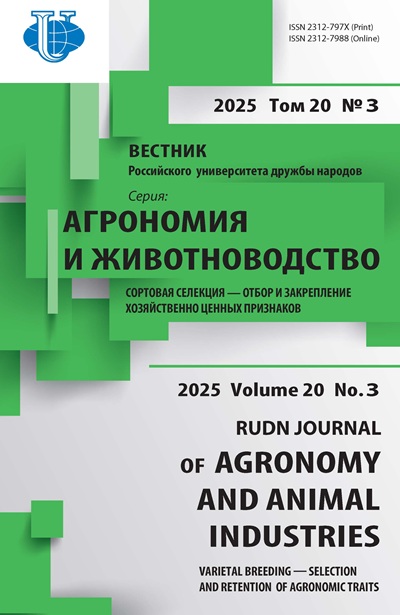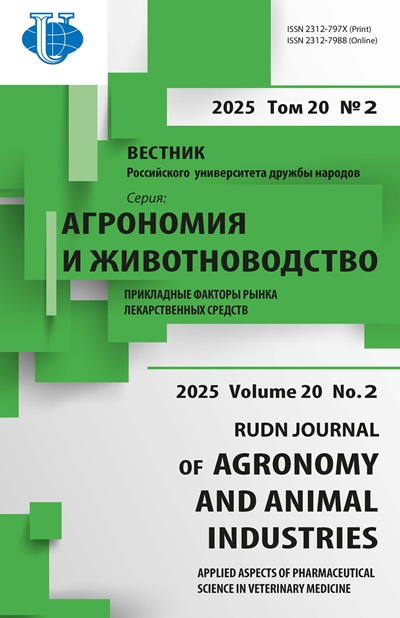Influence of complex therapy on amino acid composition of blood in calves with gastrointestinal tract diseases
- Authors: Pudovkin N.A.1, Apieva E.Z.2, Smutnev P.V.1
-
Affiliations:
- Saratov State University of Genetics, Biotechnology and Engineering named after N.I. Vavilov
- Penza State Agrarian University
- Issue: Vol 20, No 2 (2025): Applied aspects of pharmaceutical science in veterinary medicine
- Pages: 227-238
- Section: Applied aspects of pharmaceutical science in veterinary medicine
- URL: https://agrojournal.rudn.ru/agronomy/article/view/20196
- DOI: https://doi.org/10.22363/2312-797X-2025-20-2-227-238
- EDN: https://elibrary.ru/MYLXIW
- ID: 20196
Cite item
Full Text
Abstract
Significant changes in the amino acid composition of the blood were found in calves with dyspepsia. Amino acid analysis showed a heavy decrease in the levels of specific non-essential and essential amino acids in calves with dyspepsia. The aim of the study was to evaluate the effect of fermented colostrum on the amino acid composition of blood during the treatment of calves with dyspepsia. Three groups of 10 day-old calves were formed for the study. The first group of animals (the control group) was fed regular colostrum without fermentation for 7 days. The second and third groups (experimental) were calves with diarrhea syndrome. The second group of calves was administered 2 ml of Flunex intramuscularly, Roncoleukin 1500 IU/kg intravenously, and Thymogen was administered to calves intramuscularly at a dose of 100 mcg per animal on the 1st and 20th days of life. A full dose of milk was given in the evening milk feeding. The third group of calves underwent the same drug therapy. But in the morning and evening milk feedings they were given a full dose of colostrum fermented by Productiv Acid SE. The use of Flunex, Roncoleukin, Thymogen for the treatment of the disease does not contribute to the full restoration of the amino acid composition of the blood. After treatment, the content of specific essential amino acids did not reach the levels of healthy animals. The total amount of amino acids was also below the control values. Adding fermented colostrum to the diet of calves that were undergoing treatment contributes to the restoration of the amino acid composition of the blood. The content of specific essential amino acids slightly differed from the control values in this group animals. The amount of non-essential amino acids increased significantly and almost reached the control values.
Keywords
Full Text
Amino acid composition of the blood of calves with gastrointestinal diseases
Amino acid name | Control | Before treatment | After treatment |
Alanine | 265.10 ± 23.87 | 207.98 ± 13.65* | 276.09 ± 41.92** |
203.98 ± 17.87* | 279.01 ± 18.01** | ||
Cysteine | 7.98 ± 0.96 | 3.98 ± 0.41* | 3.76 ± 0.33** |
5.84 ± 1.33* | 7.13 ± 0.16** | ||
Aspartic acid | 13.76 ± 1.11 | 18.15 ± 1.89* | 14.94 ± 1.87** |
19.65 ± 2.18* | 16.00 ± 1.84** | ||
Glutamic acid | 100.53 ± 13.87 | 103.01 ± 7.98 | 100.96 ± 9.13 |
113.98 ± 5.81* | 110.03 ± 8.15 | ||
Tyrosine | 56.98 ± 4.31 | 43.86 ± 5.17* | 50.65 ± 5.17** |
50.09 ± 3.81* | 53.02 ± 3.17** | ||
Glycine | 310.65 ± 40.14 | 300.91 ± 13.98 | 305.91 ± 40.12 |
265.91 ± 8.96 | 320.97 ± 23.03** | ||
Histidine | 102.87 ± 11.12 | 69.01 ± 10.13* | 70.94 ± 8.66** |
73.92 ± 6.15* | 94.93 ± 6.10** | ||
Asparagine | 76.09 ± 6.00 | 51.08 ± 6.13* | 69.81 ± 7.33** |
50.09 ± 3.81* | 78.63 ± 6.13** | ||
Proline | 173.98 ± 18.05 | 102.83 ± 9.14* | 135.09 ± 14.43** |
114.87 ± 10.03* | 156.93 ± 11.95** | ||
Glutamine | 276.91 ± 30.13 | 168.09 ± 23.87* | 207.98 ± 16.53** |
176.98 ± 9.00* | 267.94 ± 8.54** | ||
Arginine | 206.98 ± 31.09 | 143.51 ± 18.09* | 176.09 ± 19.36** |
153.90 ± 11.65* | 200.63 ± 13.16** | ||
Serin | 206.87 ± 25.91 | 137.09 ± 20.98* | 197.76 ± 14.06** |
146.02 ± 9.91* | 198.87 ± 10.66** | ||
Total amount of non-essential amino acids | 1798.70±206.56 | 1329.50±131.42* | 1609.98 ± 178.91** |
1351.17 ± 87.83* | 1787.91 ± 110.90 | ||
Isoleucine | 111.87 ± 9.06 | 101.98 ± 4.32* | 105.98 ± 8.61 |
104.95 ± 6.52* | 118.97 ± 3.14** | ||
Lysine | 147.98 ± 15.81 | 132.65 ± 12.12* | 131.97 ± 8.13 |
129.73 ± 10.06* | 154.09 ± 2.17** | ||
Leucine | 160.84 ± 21.86 | 109.76 ± 9.96* | 142.09 ± 8.01** |
107.76 ± 5.41* | 156.58 ± 7.77** | ||
Methionine | 56.92 ± 40.32 | 31.03 ± 4.15* | 48.09 ± 5.01** |
33.73 ± 2.16* | 58.76 ± 2.74** | ||
Threonine | 206.85 ± 18.09 | 121.98 ± 14.11* | 187.09 ± 12.05** |
150.07 ± 9.19* | 204.84 ± 10.06** | ||
Valin | 267.98 ± 30.91 | 189.42 ± 12.09* | 231.87 ± 18.09** |
201.65 ± 14.87* | 249.61 ± 11.632** | ||
Tryptophan | 40.93 ± 4.13 | 36.41 ± 3.15* | 39.09 ± 4.33 |
35.99 ± 1.66* | 40.37 ± 2.18** | ||
Phenylalanine | 65.81 ± 7.13 | 55.09 ± 4.13* | 63.91 ± 7.31** |
52.67 ± 2.16* | 75.98 ± 6.14** | ||
Total amount of essential amino acids | 1059.18 ± 147.31 | 778.32 ± 64.03* | 950.09 ± 71.54** |
816.55 ± 52.03 | 1059.20 ± 45.83** | ||
Total amount of amino acids | 2857.88 ± 353.87 | 2107.82 ± 195.45* | 2560.07 ± 250.45** |
2167.72 ± 139.86* | 2847.11 ± 156.73** |
Note. * p ≤ 0.05 — significance of differences relative to control ** p ≤ 0.05 — significance of differences relative to animals before treatment.
Source: compiled by N.A. Pudovkin, E.Zh. Apieva, P.V. Smutnev.
Fisher coefficient in calves
Source: compiled by N.A. Pudovkin, E. Zh. Apieva, P.V. Smutnev.
About the authors
Nikolaj A. Pudovkin
Saratov State University of Genetics, Biotechnology and Engineering named after N.I. Vavilov
Email: niko-pudovkin@yandex.ru
ORCID iD: 0000-0003-0665-1130
SPIN-code: 7309-1025
Doctor of Biological Sciences, Professor, Head of the Department of Morphology, Animal Pathology and Biology
4 Pyotr Stolypin Avenue, bldg. 3, Saratov, 410012, Russian FederationEl’za Zh. Apieva
Penza State Agrarian University
Email: elsa-apieva@yandex.ru
ORCID iD: 0000-0002-5422-5737
SPIN-code: 4930-8626
Associate Professor of the Department of Veterinary Medicine
30 Botanicheskaya Street, Penza, 440014, Russian FederationPetr V. Smutnev
Saratov State University of Genetics, Biotechnology and Engineering named after N.I. Vavilov
Author for correspondence.
Email: smutnev-asd@yandex.ru
ORCID iD: 0000-0001-8393-9336
SPIN-code: 9541-6618
Candidate of Veterinary Sciences, Associate Professor of the Department of Microbiology and Biotechnology
4 Pyotr Stolypin Avenue, bldg. 3, Saratov, 410012, Russian FederationReferences
- Tikhonov SL, Danilova IG, Tikhonova NV, Tikhonova MS, Popovskikh AD. Characteristics and study of the antimicrobial activity of the peptide fraction of trypsin hydrolysate of bovine colostrum. XXI century: results of the past and problems of the present plus. 2022;11(3):116–121. (In Russ.). doi: 10.46548/21vek-2022-1159-0017 EDN: QBCOAQ
- Lozovskaya DS, Dymar OV. Technological aspects of thermal and mechanical processing of colostrum. Food industry: science and technology. 2024;17(1):46–55. (In Russ.).
- Gorelik OV, Fedoseeva NA, Romanova NV, Dolmatova IA. The quality of cow colostrum when using a natural feed additive. Bulletin of Michurinsk State Agrarian University. 2023;(4):137–140. (In Russ.).
- Apieva EZ, Pudovkin NA, Gengin ID. Influence of fermented colostrum on hematological indicators of calves with gastrointestinal tract diseases. Bulletin of the Kursk State Agrarian University. 2024;(1):88–92. (In Russ.).
- Ershova IG. Research results of the feed value of colostrum after defrostation by endogenous heating. Bulletin of NGIEI. 2021;(12):50–61. (In Russ.). doi: 10.24412/2227-9407-2021-12-50-61 EDN: HGGISB
- Bakaeva LN, Karamaeva AS, Karamaev SV. Influence of cow fatness prior calving on the quality of the first lactation yield colostrum. Bulletin Samara State Agricultural Academy. 2020;(3):50–56. (In Russ.).
- Semenov VG, Simurzina EP, Nikitin DA, Karaulov RS, Zakharovsky GV, Luzova AV. Immune protection of calves depending on the quality of colostrum. Тhe Veterinarian. 2023;(2):33–40. (In Russ.). doi: 10.33632/1998-698X_2023_2_33 EDN: FZOBIZ
- Doroshenko EM. Structure of the pool of free amino acids and their derivatives in blood plasma of patients with ishemic heart disease and manifestations of chronic cardiac insufficiency. Journal of Grodno State Medical University. 2017;15(5):551–556. (In Russ.). doi: 10.25298/2221-8785-2017-15-5-551-556 EDN: YKYYNI
- Erimbetov KT, Obvintseva OV, Sofronova OV. Physiological significance and metabolic functions of leucine, isoleucine and valine in animals. Problems of Productive Animal Biology. 2021;(4):40–50. (In Russ.). doi: 10.25687/1996-6733.prodanimbiol.2021.4.40-50 EDN: SMEXVX
- Dam G, Sоrensen M, Buhl M, Sandahl TD, Mоller N, Ott P, Vilstrup H. Muscle metabolism and whole blood amino acid profile in patients with liver disease. Scandinavian Journal of Clinical and Laboratory Investigation. 2015;75:674–680. doi: 10.3109/00365513.2015.1074276
- Kalyuzhny II, Seitov MS, Terentyev AA, Pudovkin NA, Dezhatkina SV, Nikulin IA, Grekalova AR. Efficiency of glucose-salt solutions for the correction of metabolic disorders in calves with neonatal diarrhea syndrome. Izvestia Orenburg State Agrarian University. 2024;(4):223–229. (In Russ.). doi: 10.37670/2073-0853-2024-108-4-223-229 EDN: JSEMGY
- Hisamatsu T, Okamoto S, Hashimoto M, Muramatsu T, Andou A, Uo M, Kitazume MT, Matsuoka K, Yajima T, Inoue N, Kanai T, Ogata H, Iwao Y, Yamakado M, Sakai R, Ono N, Ando T, Suzuki M, Hibi T. Novel, objective, multivariate biomarkers composed of plasma amino acid profiles for the diagnosis and assessment of inflammatory bowel disease. PLoS One. 2012;7:31131. doi: 10.1371/journal.pone.0031131
- Kaplan M, Mutlu EA, Benson M, Fields JZ, Banan A, Keshavarzian A. Use of herbal preparations in the treatment of oxidant-mediated inflammatory disorders. Complementary Therapies in Medicine. 2007;(15): 207–216. doi: 10.1016/j.ctim.2006.06.005
- Zhang W, Xiao S, Ahn DU. Protein oxidation: basic principles and implications for meat quality. Critical Reviews in Food Science and Nutrition. 2013;53:1191–1201. doi: 10.1080/10408398.2011.577540
- Wang X, Liu Y, Li S, Pi D, Zhu H, Hou Y, Shi H, Leng W. Asparagine attenuates intestinal injury, improves energy status and inhibits AMP-activated protein kinase signalling pathways in weaned piglets challenged with Escherichia coli lipopolysaccharide. British Journal of Nutrition. 2015;114:553–565. doi: 10.1017/S0007114515001877 EDN: UQRFCT
- Newsholme EA, Carrié AL. Quantitative aspects of glucose and glutamine metabolism by intestinal cells. Gut. 1994;35:13–17.
Supplementary files
















